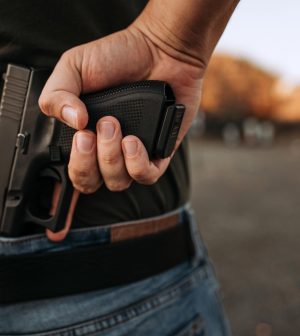- Navigating Your Midlife Crisis: Embracing New Possibilities
- City Raccoons Showing Signs of Domestication
- Mapping the Exposome: Science Broadens Focus to Environmental Disease Triggers
- One Week Less on Social Media Linked to Better Mental Health
- Your Brain Changes in Stages as You Age, Study Finds
- Some Suicide Victims Show No Typical Warning Signs, Study Finds
- ByHeart Formula Faces Lawsuits After Babies Sickened With Botulism
- Switch to Vegan Diet Could Cut Your Greenhouse Gas Emissions in Half
- Regular Bedtime Does Wonders for Blood Pressure
- Dining Alone Could Mean Worse Nutrition for Seniors
Half of Chicago’s Residents Have Witnessed a Shooting by Age 40

Living with the potential for gun violence takes a “cumulative physiological toll” on people in Chicago and across the country, said researchers whose new study found that half of that city’s residents had witnessed a shooting by age 40.
The study followed Chicagoans from childhood and adolescence in the 1990s over the course of 25 years.
Of the more than 2,400 study participants, about 56% of Black and Hispanic residents had seen at least one shooting by the time they turned 40. About 25% of white Chicagoans had witnessed a shooting by that time.
The average age that Chicago residents first witnessed a shooting was 14.
Some weren’t just seeing the gun violence, but experiencing it. More than 7% of Black and Hispanic people had been shot before turning 40, compared to 3% of white people. The average age for being shot was 17.
“We expected levels of exposure to gun violence to be high, but not this high. Our findings are frankly startling and disturbing,” said study lead author Charles Lanfear, from the University of Cambridge’s Institute of Criminology in the U.K.
“A substantial portion of Chicago’s population could be living with trauma as a result of witnessing shootings and homicides, often at a very young age,” Lanfear said in a university news release. “It is clear that Black people in particular are often living in a very different social context, with far higher risks of seeing and becoming victims of gun violence in the streets near their homes lasting into middle age.”
The research was led in collaboration with researchers from Harvard and Oxford Universities.
The Project on Human Development in Chicago Neighborhoods (PHDCN), a Harvard University study, has followed thousands of children since they were first surveyed in the 1990s.
Participants are from households randomly selected from a set list of eighty Chicago districts, which were carefully chosen to reflect Chicago’s spectrum of race and levels of social advantage.
In this latest research, the focus was on data gathered from 2,418 of participants born in the early 1980s through the mid-1990s.
The oldest study participants were born in 1981 and hit adolescence when lethal violence reached a peak in the United States.
“The ’90s saw a demographic bump collide with high poverty levels and rises in gang crime resulting in part from the crack epidemic,” Lanfear said. “However, since 2016 we have seen another surge in gun violence. Rates of fatal shootings in Chicago are now higher than they ever were in the ’90s.”
The study also found that rates of shootings within a 250-meter radius of the homes of Black participants were over 12 times higher than those of white participants. Rates of shootings near the homes of Hispanic people were almost four times higher than for white people.
Altogether, this chronic stress may have health implications for people in Chicago and other big cities.
“Existing evidence suggests that the long-term stress of exposure to firearm violence can contribute to everything from lower test scores for school kids to diminished life expectancy through heart disease,” Lanfear said.
Men were far more likely to be involved in violent crime. The risk for being shot by age 40 was five times higher for men than women.
Yet, the gap in exposure to gun violence was smaller, with 43% of women and 58% of men having seen someone get shot.
The findings were published May 9 in the journal JAMA Network Open.
“The public health consequences of life in violent and traumatized neighborhoods will be playing out not just in Chicago, but in many cities right across the United States,” Lanfear said.
More information
Pew Research Center has more on gun deaths in the United States.
SOURCE: University of Cambridge, news release, May 9, 2023
Source: HealthDay
Copyright © 2025 HealthDay. All rights reserved.










